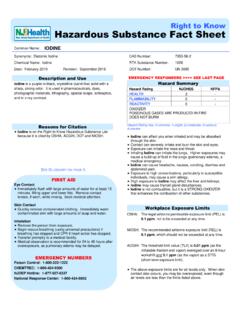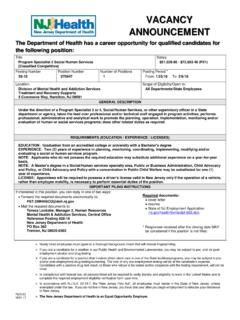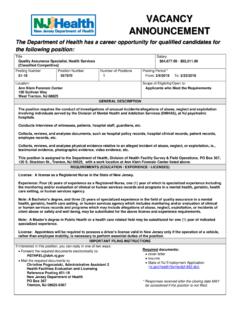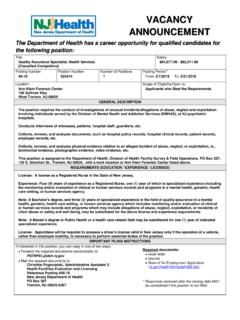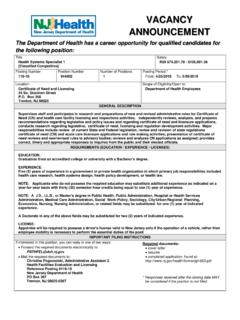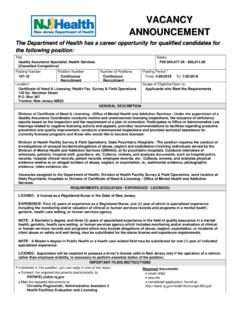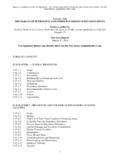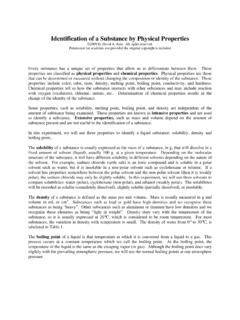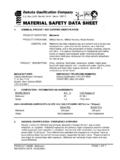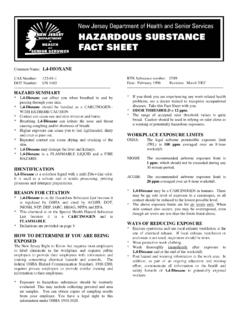Transcription of RHODIUM HAZARD SUMMARY WORKPLACE EXPOSURE …
1 Common Name: RHODIUM . CAS Number: 7440-16-6 RTK substance number: 1635. DOT Number: None Date: April 2002. ---------------------------------------- --------------------------------- ---------------------------------------- --------------------------------- HAZARD SUMMARY WORKPLACE EXPOSURE LIMITS. * RHODIUM powder can affect you when breathed in. OSHA: The legal airborne permissible EXPOSURE limit * Contact can irritate the skin and eyes. (PEL) is mg/m3 averaged over an 8-hour * RHODIUM powder may cause a skin allergy. If allergy workshift. develops, very low future EXPOSURE can cause itching and a skin rash.
2 NIOSH: The recommended airborne EXPOSURE limit is mg/m3 averaged over a 10-hour workshift. IDENTIFICATION. RHODIUM is a gray-white, hard, malleable metal. It is used in ACGIH: The recommended airborne EXPOSURE limit is corrosion-resistant electroplating and in making alloys and 1 mg/m3 averaged over an 8-hour workshift. optical instruments. WAYS OF REDUCING EXPOSURE . REASON FOR CITATION * Where possible, enclose operations and use local exhaust * RHODIUM is on the Hazardous substance List because it is ventilation at the site of chemical release. If local exhaust regulated by OSHA and cited by ACGIH and NIOSH.
3 Ventilation or enclosure is not used, respirators should be * Definitions are provided on page 5. worn. * Wear protective work clothing. HOW TO DETERMINE IF YOU ARE BEING * Wash thoroughly immediately after EXPOSURE to RHODIUM . * Post HAZARD and warning information in the work area. In EXPOSED. addition, as part of an ongoing education and training The New Jersey Right to Know Act requires most employers to label chemicals in the WORKPLACE and requires public effort, communicate all information on the health and employers to provide their employees with information and safety hazards of RHODIUM to potentially exposed training concerning chemical hazards and controls.
4 The workers. federal OSHA HAZARD Communication Standard, , requires private employers to provide similar training and information to their employees. * EXPOSURE to hazardous substances should be routinely evaluated. This may include collecting personal and area air samples. You can obtain copies of sampling results from your employer. You have a legal right to this information under OSHA * If you think you are experiencing any work-related health problems, see a doctor trained to recognize occupational diseases. Take this Fact Sheet with you. RHODIUM page 2 of 6. This Fact Sheet is a SUMMARY source of information of all WORKPLACE CONTROLS AND PRACTICES.
5 Potential and most severe health hazards that may result from EXPOSURE . Duration of EXPOSURE , concentration of the substance Unless a less toxic chemical can be substituted for a hazardous and other factors will affect your susceptibility to any of the substance , ENGINEERING CONTROLS are the most potential effects described below. effective way of reducing EXPOSURE . The best protection is to ---------------------------------------- ----------------------------------- enclose operations and/or provide local exhaust ventilation at the site of chemical release. Isolating operations can also HEALTH HAZARD INFORMATION reduce EXPOSURE .
6 Using respirators or protective equipment is less effective than the controls mentioned above, but is Acute Health Effects sometimes necessary. The following acute (short-term) health effects may occur immediately or shortly after EXPOSURE to RHODIUM : In evaluating the controls present in your WORKPLACE , consider: (1) how hazardous the substance is, (2) how much of the * Contact can irritate the skin and eyes. substance is released into the WORKPLACE and (3) whether harmful skin or eye contact could occur. Special controls Chronic Health Effects should be in place for highly toxic chemicals or when The following chronic (long-term) health effects can occur at significant skin, eye, or breathing exposures are possible.
7 Some time after EXPOSURE to RHODIUM and can last for months or years: In addition, the following control is recommended: Cancer HAZARD * Where possible, automatically transfer RHODIUM powder * According to the information presently available to the New from drums or other storage containers to process Jersey Department of Health and Senior Services, containers. RHODIUM has not been tested for its ability to cause cancer in animals. Good WORK PRACTICES can help to reduce hazardous exposures. The following work practices are recommended: Reproductive HAZARD * According to the information presently available to the New * Workers whose clothing has been contaminated by Jersey Department of Health and Senior Services, RHODIUM should change into clean clothing promptly.
8 RHODIUM has not been tested for its ability to affect * Do not take contaminated work clothes home. Family reproduction. members could be exposed. * Contaminated work clothes should be laundered by Other Long-Term Effects individuals who have been informed of the hazards of * RHODIUM powder may cause a skin allergy. If allergy EXPOSURE to RHODIUM . develops, very low future EXPOSURE can cause itching and a * Eye wash fountains should be provided in the immediate skin rash. work area for emergency use. * If there is the possibility of skin EXPOSURE , emergency shower facilities should be provided.
9 MEDICAL * On skin contact with RHODIUM , immediately wash or shower to remove the chemical. Medical Testing * Do not eat, smoke, or drink where RHODIUM is handled, If symptoms develop or overexposure is suspected, the processed, or stored, since the chemical can be swallowed. following is recommended: Wash hands carefully before eating, drinking, smoking, or using the toilet. * Evaluation by a qualified allergist, including careful * Use a vacuum or a wet method to reduce dust during clean- EXPOSURE history and special testing, may help diagnose up. DO NOT DRY SWEEP. skin allergy. PERSONAL PROTECTIVE EQUIPMENT.
10 Any evaluation should include a careful history of past and present symptoms with an exam. Medical tests that look for WORKPLACE CONTROLS ARE BETTER THAN. damage already done are not a substitute for controlling PERSONAL PROTECTIVE EQUIPMENT. However, for EXPOSURE . some jobs (such as outside work, confined space entry, jobs done only once in a while, or jobs done while WORKPLACE Request copies of your medical testing. You have a legal right controls are being installed), personal protective equipment to this information under OSHA may be appropriate. RHODIUM page 3 of 6. OSHA requires employers to determine the * Where the potential for high EXPOSURE exists, use a NIOSH.


